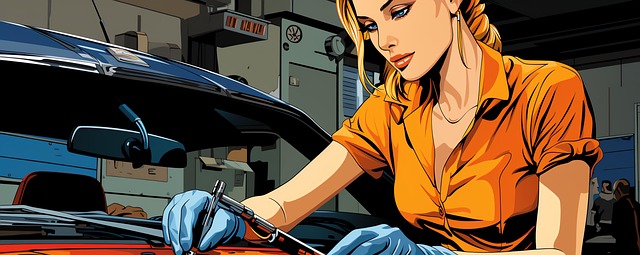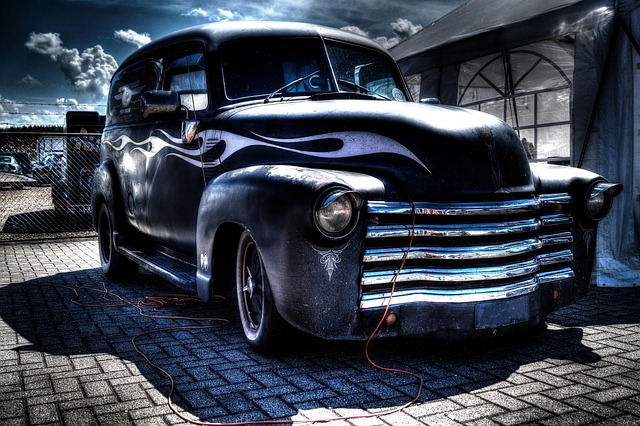Tesla Interior Trim Repair: Protecting Resale Value with DIY Tips and Professional Care
Tesla's premium interior trim is prone to wear and tear, impacting resale value. Professional r…….
In the rapidly evolving world of automotive technology, Tesla has consistently pushed boundaries, not just with its innovative electric powertrains but also through cutting-edge interior design and material choices. As a result, Tesla interior trim repair has emerged as a specialized field, demanding precision and an artistic touch. This article aims to delve into the intricacies of Tesla interior trim repair, exploring its definition, global impact, economic implications, technological innovations, regulatory landscape, challenges, case studies, and future prospects. By the end, readers will gain a comprehensive understanding of this dynamic industry segment and its significance in shaping the automotive experience.
Definition: Tesla interior trim repair refers to the specialized process of restoring, replacing, or enhancing various interior components of Tesla vehicles, ensuring they meet the brand’s high-quality standards and aesthetic vision. This includes working with materials such as leather, fabric, wood, aluminum, and stainless steel to fix or replace worn-out or damaged parts, bringing the vehicle back to its original condition or even upgrading it to reflect current design trends.
Core Components: The interior trim of a Tesla vehicle comprises several elements:
Dashboard and Instrument Panel: Central to the driver’s interaction, this area includes the touchscreen display, ventilation controls, and various indicators. Repair involves replacing cracked screens, fixing faulty buttons, or updating software to ensure optimal functionality.
Seating and Upholstery: High-quality fabrics and leathers are used extensively in Teslas. Repairing or replacing worn seats, repairing rips or tears, and re-dying stains are common tasks for interior trim specialists.
Door Panels and Trim: These elements add to the overall aesthetic appeal and include intricate details like wood grain patterns or metal accents. Damaged door panels may require replacement, while trim pieces can be refinished or repainted.
Headliner and Ceiling: The headliner, often made of fabric or leather, can be repaired for holes or tears, maintaining the vehicle’s ambiance.
Interior Accents and Hardware: This includes decorative elements like chrome or stainless steel door handles, gear shifts, and window cranks. Replacing or polishing these components ensures a consistent and luxurious feel throughout the interior.
Historical Context: Tesla’s approach to interior design has evolved over time, reflecting the brand’s commitment to sustainability, aesthetics, and technological integration. Early models featured simple yet elegant interiors with minimal trim. As Tesla introduced new vehicle lines and design updates, the complexity of interior trim increased, incorporating advanced materials and craftsmanship. The Model S, launched in 2012, was a significant milestone, showcasing a luxurious interior with customizable options, setting a new standard for premium automotive design.
Tesla’s global influence on interior trim repair is profound, as the company’s unique design philosophies and material choices have inspired and challenged the automotive industry worldwide.
North America: The US market, a hub for Tesla innovation, has seen a rise in specialized interior trim repair services, particularly in cities with high concentrations of Tesla owners. California, known for its tech-savvy culture, has become a hotbed for innovative repair techniques and custom modifications.
Europe: Tesla’s European presence, especially in countries like Germany and the UK, has led to the development of specialized workshops catering to the unique design elements found in models like the Model 3 and Model Y. The region’s emphasis on precision craftsmanship aligns well with Tesla’s standards.
Asia: In China, Tesla’s rapid growth has sparked a demand for skilled interior trim repair technicians who can handle the brand’s specific materials and designs. Tokyo, Japan, has emerged as a center for Tesla interior customization, blending traditional Japanese craftsmanship with modern automotive design.
Trends Shaping the Industry:
Sustainability Focus: Tesla’s commitment to sustainability is reflected in its interior trim choices, using eco-friendly materials and promoting recycling practices. This trend is gaining global traction, with consumers increasingly demanding environmentally conscious options.
Customization and Personalization: The rise of personalized vehicle options has led to a demand for tailored interior trim repairs and upgrades. Tesla’s over-the-air software updates enable additional customization opportunities, further fueling this trend.
Integration of Technology: Advanced infotainment systems and connectivity features are becoming integral parts of modern vehicles’ interiors. Repairing and upgrading these systems requires specialized skills and knowledge, especially as Tesla continues to push the boundaries of in-car technology.
The economic aspects of Tesla interior trim repair are multifaceted, impacting both the automotive industry and the broader service sector.
Market Dynamics:
Demand Growth: As Tesla’s global sales continue to rise, so does the demand for interior trim repair services. The company’s rapid product lifecycle, with frequent updates and new model introductions, keeps consumers engaged but presents challenges for repair shops to stay current.
Specialization and Skilled Labor: Interior trim repair requires a unique set of skills and knowledge. Specialized workshops and technicians are in high demand, commanding premium rates for their expertise.
Investment Patterns:
Automotive Manufacturers: Tesla’s influence has encouraged traditional automotive manufacturers to invest in interior design innovation, leading to more sophisticated and customizable options across various vehicle segments.
Aftermarket Industry: The aftermarket for interior trim components and accessories thrives due to consumer preferences for customization and personalized upgrades. This sector offers opportunities for repair shops to expand their services and generate additional revenue streams.
Economic Impact on Local Communities:
Job Creation: Specialized repair workshops contribute to local employment, creating skilled jobs that require expertise in automotive design and craftsmanship.
Consumer Spending: Tesla owners’ willingness to invest in high-quality interior trim repairs contributes to local economies, supporting small businesses and promoting a culture of vehicle care and customization.
Tesla’s interior trim repair process has been significantly enhanced by technological breakthroughs, improving efficiency, precision, and customer satisfaction.
3D Printing: This technology is revolutionizing interior component manufacturing, allowing for precise reproduction of intricate designs at a fraction of the time and cost compared to traditional methods. Customized repairs and unique design elements can be printed on demand.
Virtual Reality (VR) and Augmented Reality (AR): VR and AR tools enable technicians to visualize and plan complex repairs, especially when dealing with intricate wood grain patterns or custom designs. This technology enhances accuracy and reduces the risk of errors.
Advanced Materials: Tesla’s use of innovative materials like carbon fiber composites and advanced textiles offers new possibilities for interior design. These materials require specialized repair techniques to maintain their integrity and aesthetic appeal.
Digital Design Software: Advanced CAD (Computer-Aided Design) software allows for precise digital modeling of interior trim components, streamlining the design and repair process. This ensures consistency in manufacturing and repairs, especially for custom orders.
The regulatory environment surrounding Tesla interior trim repair varies across regions but generally aims to ensure consumer safety, environmental protection, and ethical business practices.
Automotive Safety Standards: Interior trim components must comply with safety regulations regarding material composition, fire resistance, and crash testing. These standards are crucial for passenger protection in the event of an accident.
Environmental Regulations: Tesla’s focus on sustainability translates into strict guidelines for recycling and proper disposal of interior trim materials. Regulations vary by region but often mandate responsible waste management practices.
Intellectual Property and Design Rights: Protecting proprietary designs and trademarks is essential, especially as Tesla continues to innovate. This includes regulations surrounding the reproduction of unique design elements or logos in repair processes.
Consumer Protection Laws: These laws safeguard consumers’ rights to receive quality services and ensure that repair shops adhere to agreed-upon standards and pricing structures.
Despite its many advantages, Tesla interior trim repair faces several challenges and criticisms:
High Cost of Specialist Services: Specialized repairs can be expensive due to the unique nature of Tesla interiors and the skill required for intricate work. This may deter some owners from pursuing necessary repairs.
Lack of Standardized Parts: Tesla’s custom designs and frequent updates mean that parts can be hard to source, especially for older models. This challenge requires efficient inventory management and a robust network of suppliers.
Quality Control Concerns: As the aftermarket for interior trim components grows, ensuring consistent quality becomes crucial. Reputable repair shops must maintain high standards to satisfy discerning Tesla owners.
Proposed Solutions:
Standardization and Documentation: Tesla could consider providing detailed documentation and standardized parts lists for discontinued models, aiding repair shops and fostering a more robust aftermarket.
Training Programs: The company can invest in training programs to enhance the skills of technicians worldwide, ensuring consistent quality standards across repairs.
Partnerships with Aftermarket Suppliers: Collaborating with reputable suppliers can ensure a steady supply of high-quality parts, keeping repair costs manageable and enhancing customer satisfaction.
A premier Tesla service center in San Francisco, California, took on the challenge of restoring a 2015 Model S with extensive interior damage due to a rear-end collision. The vehicle required replacement seats, a new headliner, and refinishing of various trim pieces. The shop utilized advanced paint matching techniques and custom upholstery patterns to return the interior to its original condition. This case highlights the intricate work involved in repairing high-end interiors while maintaining Tesla’s design integrity.
A German workshop specializing in Tesla modifications transformed a basic Model 3 into a unique, one-of-a-kind vehicle for a demanding owner. The project involved extensive custom styling, including a bespoke color scheme, upgraded seating with heated and ventilated cushions, and a personalized infotainment system. This case study exemplifies the growing trend of personalization and the creative possibilities offered by Tesla’s modular design philosophy.
In Beijing, China, a local interior trim repair shop embraced sustainability by repurposing discarded materials from Tesla production lines. They created unique interior accents for customers who sought eco-friendly options. This case demonstrates how creativity and innovation can address both consumer demands for sustainable products and the challenge of managing waste in the automotive industry.
The future of Tesla interior trim repair is promising, with several growth areas and emerging trends on the horizon:
Advanced Material Research: Continued research into new materials will drive innovation, offering lighter, stronger, and more sustainable options for interior trim components.
Digitalization and Remote Services: The rise of remote diagnostics and online ordering could revolutionize the industry, allowing customers to access repair services without physical visits.
Personalized Experiences: Tesla’s focus on customization will continue to shape the industry, with owners seeking unique interior designs tailored to their preferences.
Sustainable Practices: As environmental concerns grow, so will the demand for eco-friendly repair and recycling solutions, pushing the industry to adopt more sustainable practices.
Tesla interior trim repair is a dynamic field that reflects the brand’s commitment to automotive excellence and innovation. From its intricate design elements to its global impact, this specialized sector demands precision, creativity, and adaptability. As Tesla continues to shape the future of transportation, so too will its interior trim repair industry, influencing the broader automotive landscape and fostering a culture of craftsmanship and sustainability.
Q: How do I know if my Tesla needs interior trim repair?
A: Signs may include damaged or faded upholstery, loose trim pieces, malfunctioning electrical components, or visible wear and tear on leather or fabric. Regular inspections can help identify potential issues early on.
Q: Can I perform basic interior trim repairs myself?
A: While some basic repairs are achievable for DIY enthusiasts, most intricate work requires specialized skills and tools. It’s recommended to seek professional assistance for complex tasks to ensure a high-quality outcome.
Q: Are Tesla interior trim parts easy to source?
A: For new or discontinued models, locating specific parts can be challenging. Tesla’s exclusive design philosophy and frequent updates mean that aftermarket availability may vary. Reputable repair shops often have extensive networks to secure needed parts.
Q: How do I choose a reputable interior trim repair shop?
A: Look for shops with certified technicians, positive customer reviews, and a proven track record of high-quality work. Inquire about their warranty policies and the types of materials they use to ensure a professional and reliable service.
Q: What are some sustainable options for Tesla interior trim repair?
A: Repurposing recycled materials, using eco-friendly adhesives, and opting for sustainable fabrics and finishes are excellent ways to promote environmental responsibility in interior trim repairs. Many repair shops now offer green repair packages to cater to environmentally conscious customers.

Tesla interior trim damage ranges from light scuffs to severe panel cracks, primarily caused by ever…….

Looking to restore your Tesla’s interior? This comprehensive guide covers Model 3, S, X, and Y vehic…….

Tesla interior trim repair requires specialized knowledge and materials due to unique materials and…….

Tesla interior trim repair demands a meticulous approach, addressing common issues like material deg…….

Tesla interior trim damage ranges from minor scuffs to significant cracks, requiring professional or…….